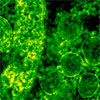Jan 10, 2022 (Nanowerk News) Gold nanoclusters are groups of a few gold atoms with interesting photoluminescent properties. The features of gold nanoclusters depend not only on their structure, but their size and also by the ligands coordinated to them. These inorganic nanomaterials have been used in sensing, biomedicine and...
Chemists use DNA to build the world’s tiniest antenna
Jan 10, 2022 (Nanowerk News) Researchers at Université de Montréal have created a nanoantenna to monitor the motions of proteins. Reported in Nature Methods ("Monitoring protein conformational changes using fluorescent nanoantennas"), the device is a new method to monitor the structural change of proteins over time – and may go...
Astronomers identify potential clue to reinonization of universe
Jan 10, 2022 (Nanowerk News) About 400,000 years after the universe was created began a period called “The Epoch of Reionization.” During this time, the once hotter universe began to cool and matter clumped together, forming the first stars and galaxies. As these stars and galaxies emerged, their energy heated...
The path to clean catalysis
Jan 10, 2022 (Nanowerk News) Chemistry professor Martin Oschatz of the University of Jena (Germany) has been awarded a coveted Starting Grant by the European Research Council to support his pioneering work, the ERC announced today. This grant, which provides up to 1.5 million euros over five years, is given...
Catalyst surface analysed at atomic resolution
Jan 10, 2022 (Nanowerk News) A German-Chinese research team has visualised the three-dimensional structure of the surface of catalyst nanoparticles at atomic resolution. This structure plays a decisive role in the activity and stability of the particles. The detailed insights were achieved with a combination of atom probe tomography, spectroscopy...
Nanotechnology strategies for plant genetic engineering
Jan 10, 2022 (Nanowerk Spotlight) Humanity's efforts to modify food plants is as old as farming itself, some 10,000 years. Before genetic engineering became possible, farmers have used simple selection inter- and intraspecies and crossing – for instance, today's strawberries are a cross between a strawberry species native to North...
Cancer therapy using on-site synthesis of anticancer drugs
Jan 10, 2022 (Nanowerk News) An international research group at the RIKEN Cluster for Pioneering Research (CPR) has successfully treated cancer in mice using metal catalysts that assemble anticancer drugs together inside the body. Published in the scientific journal Nature Communications ("Synthetic prodrug design enables biocatalytic activation in living mice...
Fusing artificial structures to natural 2D materials
Jan 10, 2022 (Nanowerk News) Hyperbolic metamaterials (HMMs), which have an extremely high anisotropy with a hyperbolic dispersion relation, are rising as an innovative method of manipulating light. HMMs have received tremendous interest in photonics for their applicability to various fields such as super-resolution imaging, negative refraction, and emission engineering....
Slow (no, fast) and steady TurtleBot wins robotic race
Jan 10, 2022 (Nanowerk News) If you’ve ever ordered a product from Amazon, chances are that a robot selected your purchase from a shelf, read the barcode and delivered it to the counter for packaging. Hopefully, it didn’t collide with a human worker on its journey and lose its way....








